Lighthouses are definitely something Portugal has in abundance – you can find one in almost every seascape! And there is a strong reason behind it. Portugal's relationship with lighthouses is deeply intertwined with its maritime heritage and rich seafaring history. With a long coastline stretching along the Atlantic Ocean, Portugal has relied on lighthouses for centuries to guide ships safely through its waters and protect its shores.
Needless to say, lighthouses have played a vital role in navigation, serving as beacons of light that guided ships along treacherous waters, warned of hazardous areas, and marked entrance points to ports. They have been instrumental in ensuring the safety of seafarers and the successful navigation of vessels in Portuguese waters.
Throughout Portugal's shoreline, lighthouses stand as silent sentinels, each with its own unique architecture and fascinating stories. These structures not only serve as navigational aids but also add a touch of beauty and charm to the scenery. Many of Portugal's lighthouses have witnessed countless maritime adventures, tales of exploration, and, inevitably, shipwrecks.
In recent years, Portugal has embraced the preservation and restoration of its lighthouses, recognizing their cultural and historical value. Several lighthouses have been converted into museums, exhibition centres, or even accommodations, offering visitors a chance to experience a new ambiance and learn about their significance.
We invite you to learn a bit more about the lighthouses considered the most beautiful and harmonious in Portugal and are still in operation today! From North to South, it is time to uncover the ever-present history of these prestigious beacons!
Praia da Barra Lighthouse
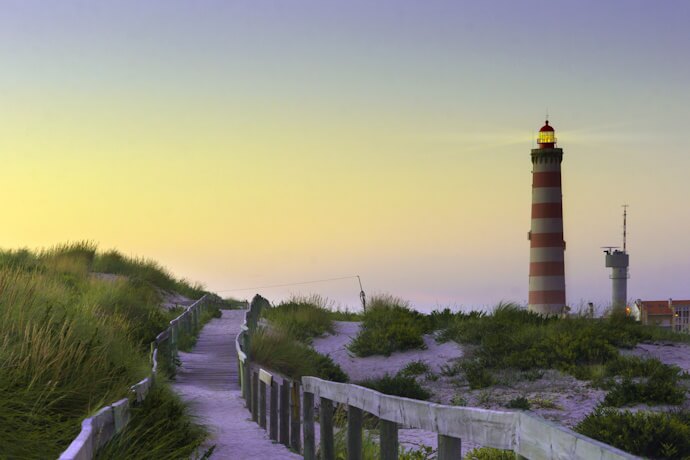
Your first stop is the Praia da Barra Lighthouse, an impressive structure with its distinctive red and white horizontal stripes located on the beach with the same name, right at the mouth of the Aveiro Lagoon. It was built in 1893 and its tower rises to a height of 62 meters (203 feet), making it one of the tallest lighthouses in Portugal. Its imposing presence and distinctive architectural style have made it an iconic symbol of the region.
More recently, the Praia da Barra Lighthouse has become a popular tourist attraction, where you can climb the tower and enjoy panoramic views of the coastline, the lagoon, and the surrounding natural beauty. From the top, you can witness breathtaking sunsets over the Atlantic Ocean and capture memorable photographs.
Adjacent to the lighthouse is a small museum that showcases the history and evolution of lighthouses in the region. The museum offers insights into the technical aspects of its operation and displays historical artifacts related to maritime navigation.
Praia da Barra itself is a picturesque seaside town known for its long sandy beach and vibrant atmosphere. The lighthouse stands at the entrance of this beautiful beach and you have a plethora of lively restaurants and cafes to choose from and shops to browse for souvenirs.
Nazaré Lighthouse
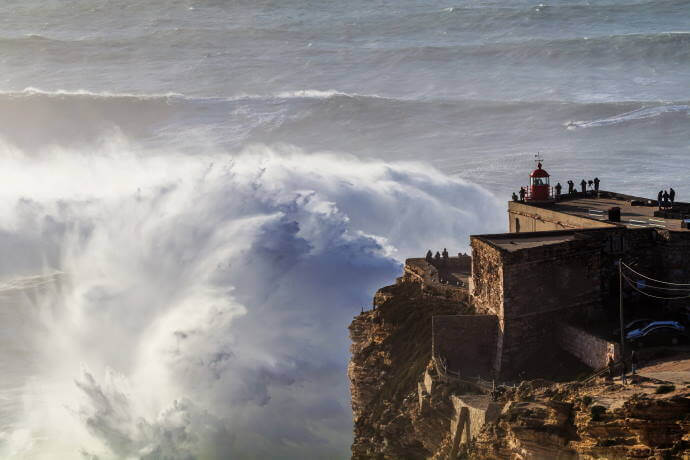
The Nazaré Lighthouse is located in the coastal town of Nazaré, in central Portugal, since 1903. It is approximately 46 meters tall (151 feet) and features a white tower with a distinctive red band around its middle section. It emits a potent beam of light that can reach a distance of 42 nautical miles, making it a crucial navigational aid for vessels. Nowadays the Nazaré lighthouse is easily accessible and you can even climb to its upper levels, to fully enjoy the panoramic views of the vast ocean and the picturesque town of Nazaré.
But there is a particular allure to this lighthouse – its location - due to Nazaré's reputation as a world-renowned surfing destination. The massive waves that break along the seaside of Nazaré, often reaching towering heights, attract surfers from all over the globe. The lighthouse serves as a vantage point to observe these massive waves and the daring surfers who challenge them. The area around the lighthouse is also known for its quaint charm, with narrow streets, traditional fishing boats, and vibrant seafood restaurants that showcase the town's rich maritime culture.
The beacon’s dominant presence atop the cliffs of Nazaré combined with its scenic background and connection to the world of big wave surfing make it a must-visit destination. And you must go all the way to the top!
Cabo da Roca Lighthouse
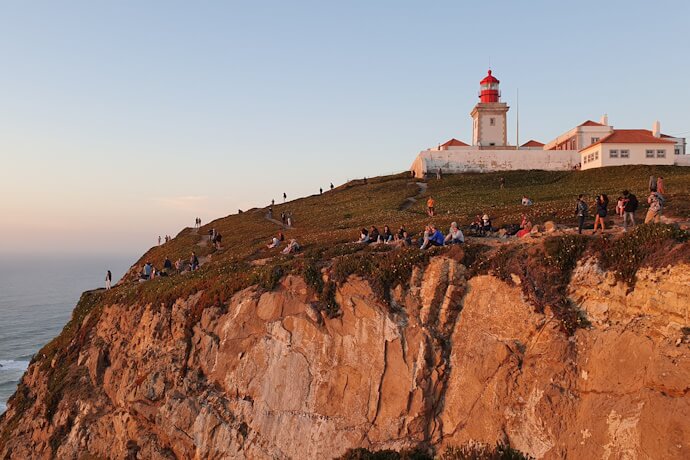
The Cabo da Roca lighthouse is an iconic 22-metre landmark located on the westernmost point of Europe. Recognisable against the dramatic backdrop of the Sintra-Cascais Natural Park's cliffs, this lighthouse from 1772 offers wondrous views of the shoreline. Over the years, the structure has undergone several renovations and upgrades to improve its functionality and ensure its pivotal continued service.
Aside from its practical purpose, the lighthouse has become a highly popular tourist attraction. On a first instance, for its jaw-dropping views of the Atlantic, with waves crashing against the rocks below. Then, for being the westernmost point of Europe, marked by a stone monument that bears the inscription "Where the land ends and the sea begins."
Adjacent to the lighthouse is a small visitor centre where it is possible to learn more about the history and relevance of Cabo da Roca and Portugal's maritime heritage.
If you are seeking adventure, this area has hiking trails that allow you to explore hidden coves and beaches. Thus, Cabo da Roca's allure extends to the wild and untamed natural beauty of the cliffs and the Atlantic Ocean, which create an outstanding sense of grandeur.
Cabo Espichel Lighthouse
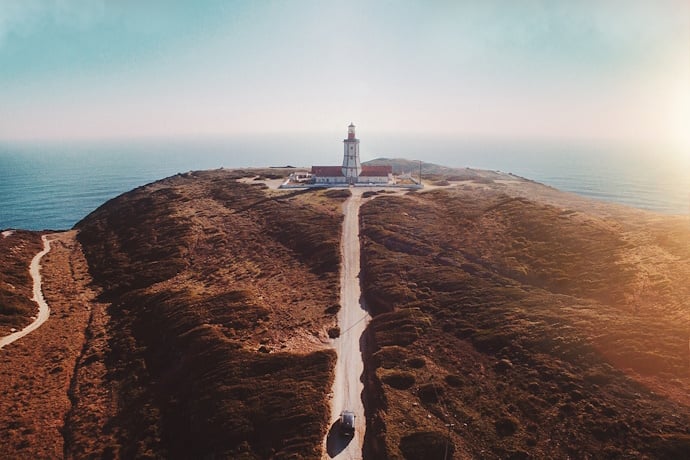
The Cabo Espichel Lighthouse is nestled among the windswept cliffs of Cabo Espichel. Located near the town of Sesimbra, southwest of Lisbon, this lighthouse holds both cultural and scenic importance, having been built in 1790, while navigations were still a relevant part of Portuguese history.
One of the special aspects of the Cabo Espichel Lighthouse is its location within the expansive Sanctuary of Our Lady of Cabo Espichel. This religious site, from the 14th century, includes a church, a chapel, and several other buildings that have served as a place of pilgrimage and worship for centuries. Together, these two structures create a captivating juxtaposition of man-made and natural elements, blending maritime history and religious heritage. The spectacular backdrop of the cliffs, the vast landscape, and the crashing waves below add to the enchanting atmosphere of the site.
If you visit Cabo Espichel, you will have the opportunity to explore the lighthouse and have a glimpse into Portugal's maritime past while enjoying the coastal beauty that characterizes this part of the country. It is possible for you to venture to this remote and picturesque location through the cliffs and trails as well, to properly experience the natural wonders of the region.
Cabo de São Vicente Lighthouse
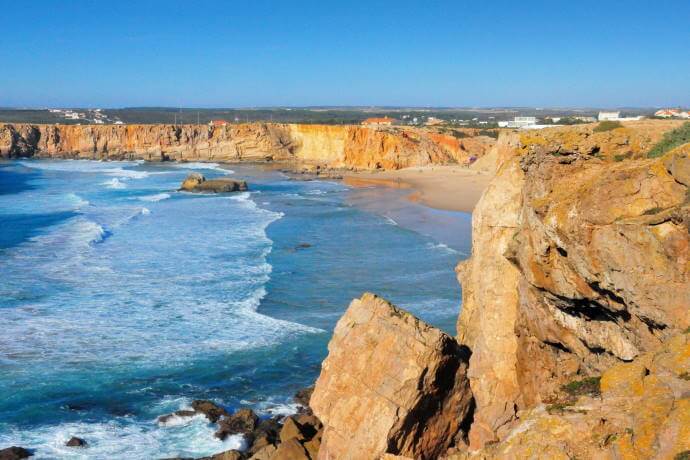
You have reached the Algarve region in Portugal! Starting in the southwesternmost point of Europe, the Cabo de São Vicente Lighthouse is an iconic maritime landmark perched on the rocky cliffs of Cape St. Vincent, near the town of Sagres.
This lighthouse holds a very long navigational past. Its origins date back to the 16th century, since it started as a tower built in the convent of São Vicente in 1515, where there was a constant light, probably a bonfire, in order to help guide the sailors. However, this illuminating tower “only” became a proper lighthouse in 1846, with a height of 24 meters (79 feet), overlooking the immeasurable expanse of the Atlantic Ocean. Its distinctive white tower, topped with a red lantern room, creates a striking visual contrast against the cliffs and the surrounding natural beauty.
Cape St. Vincent has been a notable site since ancient times, associated with myths, explorations, and maritime discoveries. It was believed to be the "End of the World" during the Age of Discoveries and served as a starting point for numerous exploratory expeditions.
Right next to the lighthouse, there is a visitor centre where you can get to know more details about the history, geology, and marine life of the region. It also offers opportunities for hiking, birdwatching, and exploring the nearby Sagres Fortress, a historical fortification associated with Prince Henry the Navigator. But we know this lighthouse’s main allure is the mesmerizing sunset views over the glowing Atlantic Ocean and its powerful waves.
Vila Real de Santo António Lighthouse

The Vila Real de Santo António Lighthouse, located at the opposite end of St. Vincent lighthouse, in the eastern Algarve, is a more recent beacon, built in 1923, that adds a quaint look to the area. It does not have as much history as the other lighthouses mentioned above, but it still had an equally significant role for the seafarers of the region in the 20th century. It has a 46-meter-tall tower (151 feet) and a modest structure, typically characterized by its tower topped with a lantern room.
Situated near the Guadiana River, which forms the border between Portugal and Spain, the Vila Real de Santo António Lighthouse offers delightful views of the river and the adjacent town. It is a symbol of maritime heritage and the town's connection to the sea.
While visiting this region, you should definitely take a relaxing stroll along the waterfront promenade to admire the sights of the lighthouse and capture the beautiful littoral atmosphere.
Capelinhos Lighthouse
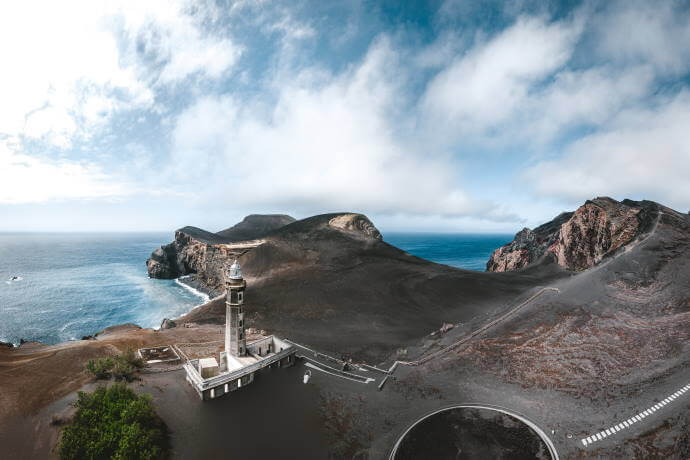
It is now time to fly across the treacherous Atlantic Ocean towards the Azores islands to find other amazing lighthouses.
The first one we are going to mention is the Capelinhos Lighthouse, located on the Capelinhos Volcano, on the island of Faial.
This lighthouse was inaugurated in 1903 and performed its nautical duties until 1957, when the Capelinhos Volcano suddenly erupted, resulting in the displacement of local residents and the formation of new land masses. The lighthouse itself was partially buried in volcanic ash and became inoperative.
Today, the Capelinhos Lighthouse is completely renovated and offers a unique opportunity to learn about the volcanic eruption and its impact on the local landscape. The Capelinhos Volcano Interpretation Centre provides comprehensive information about the eruption and the geological processes that shaped the area.
The lighthouse's architecture is distinctive, with its cylindrical shape and a slightly dark exterior that ends up blending with the volcanic terrain. You can, as expected, climb to the top of the lighthouse to enjoy panoramic views of the volcanic scenery, the ocean, and the neighbouring islands. However, this time the ground floor might be even more exciting since you can explore the volcanic terrain, walk along the lava fields and witness the stark contrast between the newly formed land and the already existing landscape.
Arnel Lighthouse
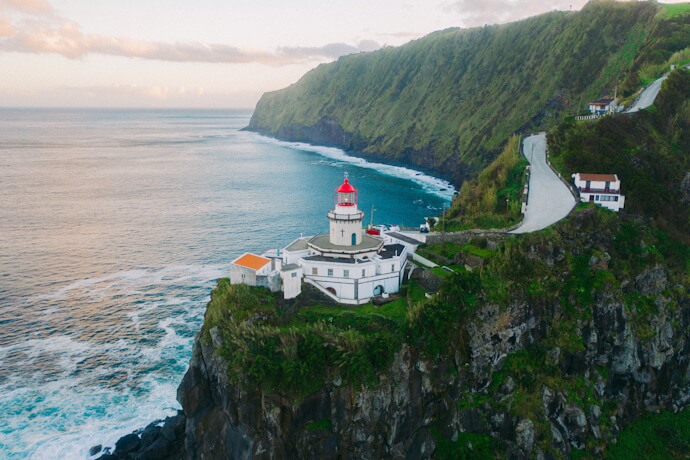
Now on the biggest island of the Azores archipelago, you will encounter the Arnel Lighthouse, situated on Ponta do Arnel, a rocky headland on the northeastern coast of the São Miguel island.
This lighthouse from 1876 has an elevation of approximately 66 meters (217 feet) above sea level, offering commanding views of the Atlantic Ocean and the irregular coastline of São Miguel. Its typical design features a white tower with a red lantern room, which makes it very visible in the natural beauty.
Apart from the postcard-worthy snapshots you can take of the gorgeous views from the lighthouse, it is also recognized for preserving and protecting the local ecosystem. The nearby marine area is home to diverse marine life, including seabirds, dolphins, even whales, and the Arnel Lighthouse is a reminder of the need to safeguard these natural habitats and promote responsible maritime practices.
Ponta do Pargo Lighthouse
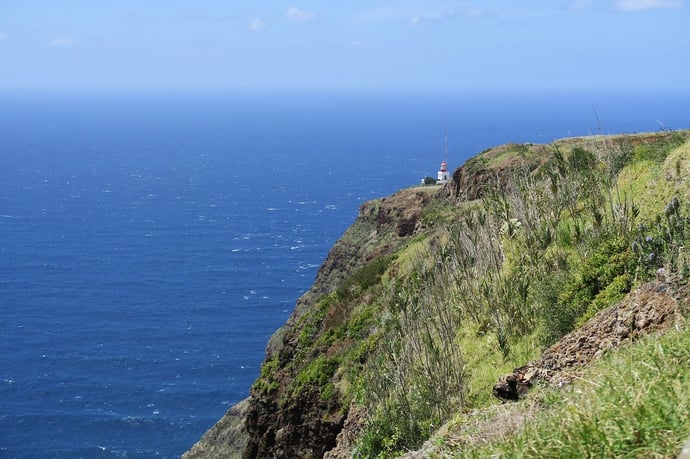
You are about to reach your final destination and what better way to do so than on the westernmost point of the island of Madeira, in the Madeira archipelago? The Ponta do Pargo Lighthouse is a renowned symbol of the island's maritime heritage, found on top of a cliff overlooking the Atlantic Ocean.
The history of the Ponta do Pargo Lighthouse dates back to 1922 when it was built to guide ships navigating the waters off Madeira's western coast. It stands at an impressive height of approximately 312 meters (1,024 feet) above sea level, making it one of the highest lighthouses in Portugal. Its cylindrical tower, painted in distinctive white and red colours, stands out against the background of the cliffs and the deep blue ocean.
By visiting the Ponta do Pargo Lighthouse you will be rewarded with stunning views of the ocean, coastal scenery, and dazzling sunsets. The lighthouse provides a vantage point for observing the waves crashing against the cliffs and the endless expanse of the Atlantic stretching into the horizon.
Apart from the lighthouse, you can also explore the rugged terrain and enjoy walking trails that meander along the cliff edges. The area is known for its natural beauty, with prominent rock formations, endemic flora, and diverse bird species. Nearby, there is a viewpoint called Miradouro da Ponta do Pargo, which offers an even wider perspective of the coastal landscape and the lighthouse itself.
Ready to visit these guardians of the coast?
We believe the relationship between Portugal and its lighthouses is one of respect, admiration, and appreciation. These iconic guardians of the coast have played a crucial role in maritime safety and continue to do so, equipped with modern technology to guide ships and prevent accidents along the shores. They symbolize Portugal's commitment to navigation and the preservation of its prestigious nautical heritage.



